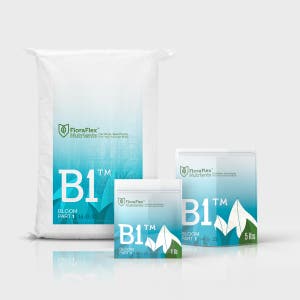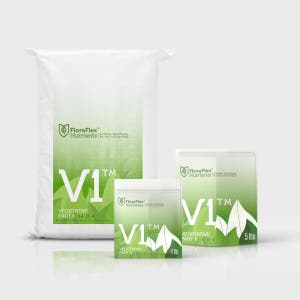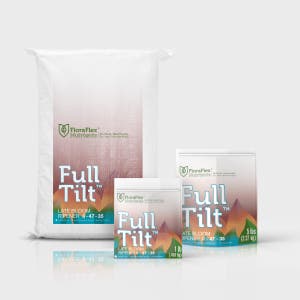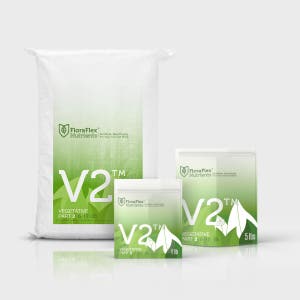Calcium and magnesium, or Cal-Mag, are two of the most misunderstood nutrients in plant cultivation. While they’re essential for healthy growth, misinformation leads to overuse, underuse, or unnecessary supplementation. Do all plants need Cal-Mag? Should you add it to every feeding? And how do you fix deficiencies when they arise?
This blog will debunk common myths, explore FloraFlex’s balanced solutions, and teach you when and how to use Cal-Mag effectively. Whether it’s root feeding, foliar spraying, or ensuring your base nutrients have the right balance, this guide gives you everything you need to optimize your grow.
Why Calcium and Magnesium Are Essential for Plants
Calcium (Ca) and magnesium (Mg) are secondary nutrients, but they play vital roles in plant growth, structure, and photosynthesis.
The Role of Calcium (Ca):
- Builds strong cell walls and prevents tissue collapse.
- Supports root development and nutrient uptake.
- Prevents common issues like tip burn and blossom-end rot.
The Role of Magnesium (Mg):
- Central to chlorophyll production, driving photosynthesis.
- Helps transport energy through the plant.
- Deficiencies cause chlorosis (yellowing between veins) and reduced energy efficiency.
"Are you feeding your plants what they need—or just guessing? Misusing Cal-Mag can harm your grow more than it helps. Learn the truth about calcium, magnesium, and how to fix deficiencies the smart way."
Debunking Cal-Mag Myths
Let’s clear up the confusion with some of the most common misconceptions about Cal-Mag:
Myth 1: All Plants Always Need Additional Cal-Mag Supplements
Truth: Not true. FloraFlex’s base nutrients, V1 (or B1) and V2 (or B2), already include calcium and magnesium in balanced amounts. Over-supplementing can cause more harm than good.
- V1/B1: Supplies calcium for structural growth.
- V2/B2: Provides magnesium for photosynthesis.
Myth 2: You Should Add Cal-Mag to Every Feed
Truth: Overloading Cal-Mag leads to nutrient lockout, preventing plants from absorbing other critical nutrients like potassium or iron. Supplement only when needed.
Myth 3: Hard Water Means You Don’t Need Cal-Mag
Truth: Hard water may have calcium, but it often lacks magnesium. Testing your water is critical to maintaining the correct Ca:Mg ratio.
Myth 4: RO Water Always Requires Heavy Cal-Mag Supplements
Truth: Reverse osmosis (RO) systems strip minerals, but adding too much Cal-Mag can cause imbalance. FloraFlex Wet CalMag offers precision supplementation without guesswork.
Signs of Calcium and Magnesium Deficiencies
Calcium Deficiency Symptoms:
- Curling, deformed leaves.
- Weak stems and poor root growth.
- Tip burn or blossom-end rot on fruits and flowers.
Magnesium Deficiency Symptoms:
- Yellowing between leaf veins (interveinal chlorosis).
- Purpling stems and veins.
- Reduced photosynthesis and overall growth.
FloraFlex Base Nutrients: The Built-In Cal-Mag Solution
FloraFlex simplifies nutrient management with base nutrients designed to include calcium and magnesium:
- V1/B1: Calcium for strong roots and structural support.
- V2/B2: Magnesium for efficient photosynthesis and energy transfer.
This eliminates the need for additional supplementation in most cases, saving you time, money, and effort.
When to Use FloraFlex Wet CalMag
While FloraFlex base nutrients cover most needs, some situations require additional Cal-Mag. Wet CalMag is the perfect solution for:
- Soft or RO Water Systems: Replenishes calcium and magnesium stripped out by filtration.
- Visible Deficiencies: Use Wet CalMag to fix curling leaves, tip burn, or chlorosis.
- Heavy-Feeding Plants: Some crops require more calcium and magnesium during peak growth phases.
- Foliar Spraying: Rapid correction of deficiencies when symptoms appear.
The Power of Foliar Spraying for Fast Results
Foliar spraying is a game-changing method for fixing calcium or magnesium deficiencies quickly. It delivers nutrients directly to the leaves, bypassing the root system and ensuring immediate absorption.
How to Foliar Spray Wet CalMag:
- Mix Wet CalMag at the recommended dilution rate.
- Spray evenly on the leaves, focusing on the undersides where stomata are located.
- Avoid spraying during peak light hours to prevent leaf burn.
Pro Tip: Use foliar spraying as a quick fix while adjusting your root-zone feeding for long-term balance.
"One nutrient imbalance could cost you your yield. Get it right with FloraFlex."
Circulation Pumps vs. Air Stones: Why It Matters
Air stones can disrupt the stability of calcium and magnesium in your reservoir by causing excessive aeration, leading to pH fluctuations and nutrient precipitation. Circulation pumps are a superior alternative because they:
- Prevent nutrient separation and lockout.
- Ensure even mixing for consistent distribution.
- Eliminate the risk of algae buildup from over-aeration.
Customer Testimonials: Real Grower Success
- "Foliar Spray Saved My Plants!"
"I had chlorosis mid-veg. A quick foliar spray of Wet CalMag fixed it in days!" – Jamie L., Indoor Grower - "The Perfect Balance!"
"With FloraFlex V1 and V2, I don’t have to guess about calcium and magnesium anymore. It’s already in there!" – Sarah P., Commercial Grower - "RO Water? No Problem!"
"FloraFlex Wet CalMag keeps my filtered water balanced and my plants thriving." – Marco G., Hobbyist Grower






















